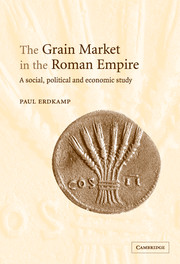Book contents
- Frontmatter
- Contents
- List of maps
- Acknowledgements
- Map 1 Asia Minor
- Map 2 Greece
- Map 3 Italy
- Map 4 The Roman World
- Map 5 Egypt
- Introduction
- 1 Production and productivity in Roman agriculture
- 2 The world of the smallholder
- 3 Farmers and their market relations
- 4 Market integration: connecting supply and demand
- 5 Rome and the corn provinces
- 6 Urban food supply and grain market intervention
- Conclusions
- References
- General index
- Index locorum
3 - Farmers and their market relations
Published online by Cambridge University Press: 04 November 2009
- Frontmatter
- Contents
- List of maps
- Acknowledgements
- Map 1 Asia Minor
- Map 2 Greece
- Map 3 Italy
- Map 4 The Roman World
- Map 5 Egypt
- Introduction
- 1 Production and productivity in Roman agriculture
- 2 The world of the smallholder
- 3 Farmers and their market relations
- 4 Market integration: connecting supply and demand
- 5 Rome and the corn provinces
- 6 Urban food supply and grain market intervention
- Conclusions
- References
- General index
- Index locorum
Summary
INTRODUCTION
We know surprisingly little about the operations of the grain trade in the Roman world. Our sources offer some evidence on the beginning of the chain, i.e. the market relations of the farmers, and the end of the chain in the urban market. The various stages in between and the middlemen involved remain relatively in the dark. This is not to deny that the epigraphic and literary sources mention many individuals, who present themselves – or are presented – as grain traders and merchants, but we have little idea of how the grain trade functioned, while also archaeology, because of the perishable nature of grain and its containers (sacks), has little to offer in this regard. Studies of the grain trade in later times may therefore contribute to our understanding of antiquity – though not in the sense that we may project the details of the later grain trade onto the Roman world. Two general features of the grain trade in medieval and early modern Europe are of importance to our understanding of the workings of the trade in the Roman Empire.
First, the grain trade was seldom a specialised business. In contrast to the Baltic grain trade dominated by Dutch merchants, large-scale businessmen in, for instance, France or southern Europe did not invest most of their capital in or derive most of their profits from the grain trade.
- Type
- Chapter
- Information
- The Grain Market in the Roman EmpireA Social, Political and Economic Study, pp. 106 - 142Publisher: Cambridge University PressPrint publication year: 2005



